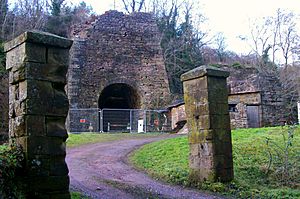Whitecliff Ironworks facts for kids
Quick facts for kids Whitecliff Ironworks |
|
|---|---|
 |
|
| Location | Gloucestershire, England, UK |
| OS grid reference | SO56751005 |
| Lua error in Module:Location_map at line 420: attempt to index field 'wikibase' (a nil value). | |
Whitecliff Ironworks, also known as Whitecliff Furnace, is an old industrial site near Coleford, in the Forest of Dean, Gloucestershire, England. It was a place where people made iron using a special fuel called coke.
Contents
Making Iron in the Forest of Dean
For hundreds of years, the Forest of Dean was a very important place for making iron. People used charcoal as fuel back then. The area had lots of iron ore and plenty of wood for charcoal.
In 1709, the first furnace to use coke instead of charcoal was built in Coalbrookdale, Shropshire. Even though the Forest of Dean had a lot of coal, its coal wasn't perfect for making the best coke for iron. So, local iron makers were slow to try this new method.
It wasn't until the late 1700s that coke-fired furnaces started appearing in the Forest of Dean. Places like Cinderford Ironworks, Whitecliff, and Parkend Ironworks were all built around the same time.
Building Whitecliff Ironworks
Work on Whitecliff Ironworks began in 1798. It was the second coke-fired furnace in the Forest of Dean. The main idea for building it came from Shropshire. However, a local businessman named James Teague was also part of the team.
Building the furnace was tough because of floods. But the furnace finally started working in 1801 or 1802. By 1808, most of the first owners had sold their shares. Whitecliff was then owned by Thomas Halford, James Teague, Isaiah Birt, and Wickenden.
James Teague managed the daily work at the site. But Thomas Halford, a stockbroker from London, owned most of the company. He was the main person driving everything forward.
Expert Help from David Mushet
Halford wasn't happy with how much iron the works were making. In 1808, he asked David Mushet for help. Mushet was a famous expert in metallurgy (the science of metals) from Scotland. Halford offered to pay him for his advice on rebuilding the works.
Mushet designed and watched over the rebuilding project between 1808 and 1810. At the same time, he was also managing another ironworks in Derbyshire.
Mushet Takes Over
In February 1810, Mushet moved to Coleford to manage Whitecliff full-time. This happened after Halford bought out his other partners. Halford then started a new partnership with Mushet and another investor named Spicer.
But after only six months, Mushet left the partnership. He usually didn't make quick decisions, so the exact reasons are not fully clear. Some historians think he disagreed with Halford. However, letters between them show they were still friendly after the split.
Another idea is that Halford might have had problems with his other businesses. He went bankrupt in 1816. But historian Ian Standing thinks the most likely reason was technical issues. He suggests it was hard to work with the local iron ore and the coke was expensive and not suitable.
The End of Iron Making
Whatever the reason, Mushet left Halford to run Whitecliff alone in late 1810 or early 1811. We don't know how much iron was made after 1810. But iron production stopped completely by 1816, and maybe even as early as 1812.
There is no sign that iron was ever made at the site again. It seems the place quickly fell into disuse. In 1827, many parts of the iron-making equipment were moved to Cinderford Ironworks. A map from 1852 shows the buildings looking much like they do today. Over the years, parts of them were used as building stones.
Preserving Whitecliff Ironworks
In the late 1940s, a company called Samuel Osborn & Company researched the site for their 100th anniversary. This research was even featured in a local newspaper in 1949. More interest in Whitecliff grew after it appeared in several books in the 1950s and 60s.
In August 1968, Whitecliff Furnace finally got a special order to protect it as a historic building. But preservation work didn't start until 1981. The Dean Heritage Museum Trust bought the remains of Whitecliff Ironworks in 1983.
In August 2011, a big project to fix up the site began. It cost £65,000 and was paid for by the Heritage Lottery Fund and Forest of Dean Local Action. Today, the Whitecliff site is open for everyone to visit and see.

